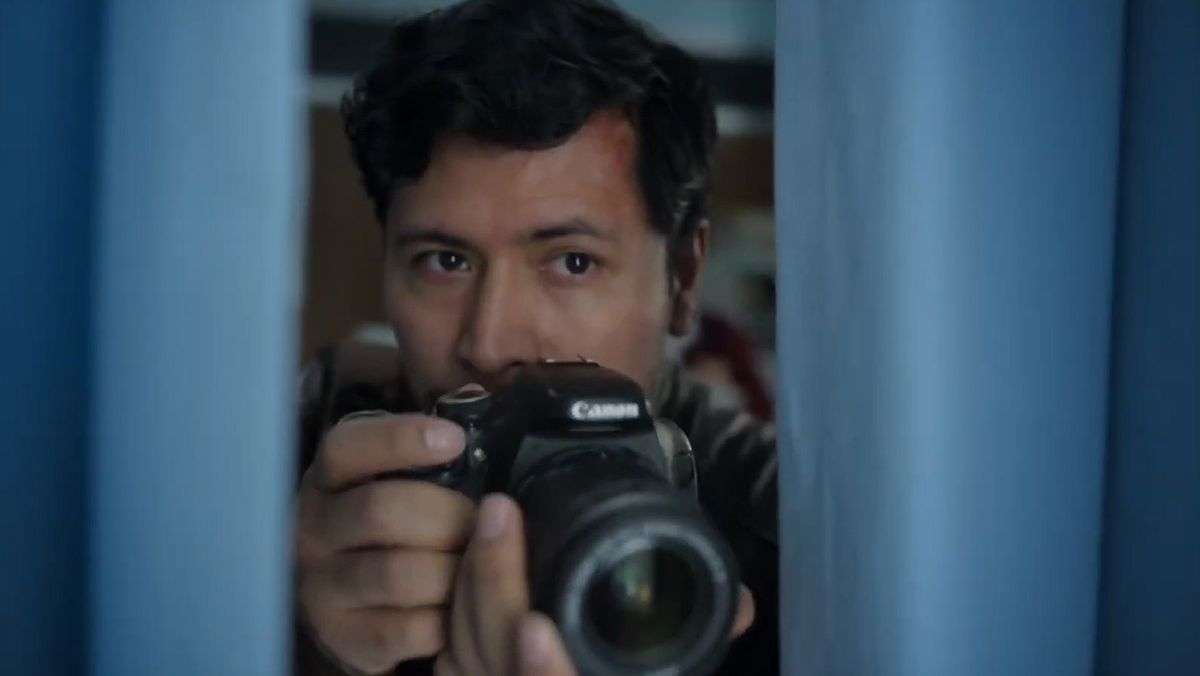“Disappear Completely” (Original Title: Desaparecer Por Completo) is a slow-burn, atmospheric horror film directed by Luis Javier Henaine. The film had been selected at FIC Morelia 2023. With its lead actor, Harold Torres, present in almost every scene, it pivots around a photographer who gets struck by a curse and finds his life swiftly shattering. Certain slivers of hope and solutions emerge, but everything turns out to be in vain as he cannot outdo the fierce, destructive power of the curse that has been set on him.
Disappear Completely (2024) Plot Summary & Movie Synopsis:
Harold Torres plays Santiago, a photographer who has been struggling for years to make his big break. Despite his sustained efforts, he is unable to crack an opportunity that will effectively redesign and propel his career and turn him into a person of repute and notice. He leads a mechanical life with his wife, Marcela (Tete Espinoza). They have been together for fourteen years. She is extraordinarily patient and supportive, but she seems to be on the brink of exhaustion, seeing how he is hopelessly stuck and unable to get any boost in his career.
He and Marcela had agreed they wouldn’t be having any kids. They have been opposed to bringing a child into this harsh, violent, and cruel world, although it seems he is the one who had been more dead set against the prospect of having kids. She could have possibly flirted with the option and given it more consideration than Santiago. When she pops the fact of her being several weeks into pregnancy, he is taken aback.
He is furthermore perturbed as she proposes keeping the child. She reasons with a vehemently opposed Santiago that a child could be the best thing that has happened to them. He comes across as a rather self-centered individual who cannot quite see beyond the scope of what he can achieve. We gauge that for most of their marriage, she has had to take the backseat in making decisions, with him determining them. Marcela letting go of the charge and having him hold it might be a gesture of her compassion and acknowledgment of his desperate efforts to kick his career into motion.
He gets a tip about a senator who had been attacked at his house. As he ventures inside the house, he sees a scurry of rats. He takes ample photographs of the crime scene as the senator lies terribly battered and unconscious. On his way home, he is knocked unconscious by a mugger. He loses his camera and IDs, retaining only his memory card that contains the pictures. It turns out to be a dangerous possession, setting him off on a strange, deadly streak from which escape becomes impossible.
As he gets another tip on a dead woman, he arrives on the scene. When he is all alone photographing her, she jolts alive and rams into him. Santiago suffers a seizure, which worsens as he loses a sense of smell and taste. The doctors can detect no virus or any brain damage that could be behind the peculiar loss of stimuli. Things take dramatic, severe turns as Santiago’s situation exacerbates. He finds a dead toad dumped in a corner of his house.
On the advice of a friend, he seeks the counsel of a woman skilled in battling voodoo. She tells him a powerful curse has been put on him. To counter it, he is compelled to perform a sacrifice, which he does for his dog. The ritual seems to go alright, but Santiago realizes it hasn’t panned out successfully as he discovers he is going deaf. His wife finds an insect lodged inside his ear, and he feels sure that the curse hasn’t been negated.
Disappear Completely (2024) Movie Ending Explained:
Does Santiago succeed in repealing the curse?

Santiago decides to investigate the senator’s attack and learns his opponent, Elena, has discernible links to witchcraft. After seeking out her ex-chauffeur and despite his strict foreboding, he heads to the haunt of the man who has engineered the curses she has ordered. He arrives at the spooky spot to find all sorts of peculiar exhibits and tools deployed for black magic. The mysterious man whom Santiago is seeking stays out of focus as he lays down the condition that can liberate Santiago if he accedes to it.
Santiago’s senses are numbed furthermore as he initially protests that he will not give up his spawn which the man desires in order to repeal the curse. Somehow, he makes it back to his home. He has wholly lost his hearing, which the film mirrors in its deliberately fuzzy, inchoate sound design. We don’t get to hear the tense, fraught, and emotional conversation that happens between him and his wife.
When she’s not looking, he spikes her coffee with the stuff the man had given him. He seems to have prioritized his life but soon alters his decision as he swats away her coffee. The decision completes an arc, in a tragic vein, of Santiago’s characterization, going from a narrow self-serving lens to accepting other possibilities, even if they aren’t to his advantage.
Disappear Completely (2024) Movie Review:
One of the most striking things about Henaine’s film is its deliberate abstinence of background information. It is a calculated decision that works to varying ends. But some crucial links are critically missing, detracting from wholly immersing ourselves in all the tendrils of the narrative. By reserving much of its mystery, the film makes a clear statement about its nature and what kind of narrative design it is interested in. The screenplay by Ricardo Aguado Fentanes and Henaine is geared towards a subjective, intimate exploration of its protagonist as he hurtles to his doom. The premise is flaky, and so is the psychological, or rather thematic, underpinning to the entire thing.
The film opens ambitiously enough with a Susan Sontag quote heralding the central connection between photography and death. Specifically put, the heedless manner in which photographers prey on the dead to feed their careers is primed as the engine that drives the witchy plotting behind the protagonist’s rapid annihilation. The film suggests the photographer invited his own death by dint of his terrible deeds of voyeuristically and irresponsibly filming and making available representations of the dead. It is among the many baffling designs of the film, that toys with various shady, murky possibilities but refrains from fully diving into them.
This creates several nagging inconsistencies in the film, along with grating, skin-deep stereotypical representations of an indigenous ritual, lazily conceived bursts of nightmarish vision, and a jarringly hastened coda that unsuccessfully and unpersuasively makes its determinant links between the mysterious attacks and the orchestrations behind them.





![In the Mouth of Madness [1994]: Twisted. Trippy. Terrifying.](https://79468c92.delivery.rocketcdn.me/wp-content/uploads/2018/07/in-the-mouth-of-madness-screenshot-3-768x322.png)



